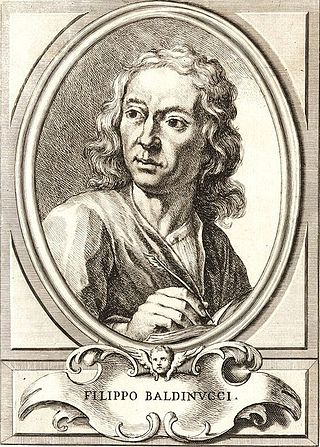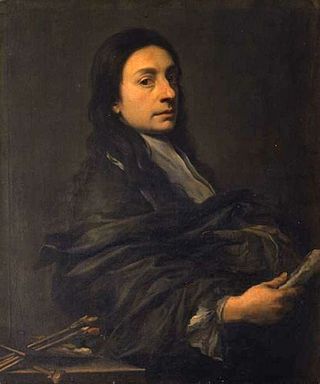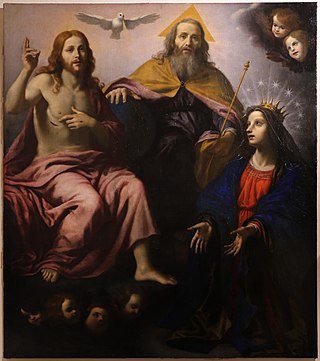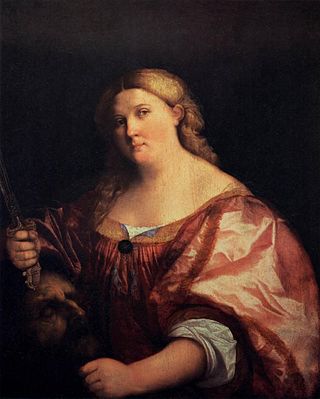Related Research Articles

Filippo Baldinucci was an Italian art historian and biographer.

Pistoia is a city and comune in the Italian region of Tuscany, the capital of a province of the same name, located about 30 kilometres (19 mi) west and north of Florence and is crossed by the Ombrone Pistoiese, a tributary of the River Arno. It is a typical Italian medieval city, and it attracts many tourists, especially in the summer. The city is famous throughout Europe for its plant nurseries.

The Accademia di Belle Arti di Firenze is an instructional art academy in Florence, in Tuscany, in central Italy.

The Gallerie dell'Accademia is a museum gallery of pre-19th-century art in Venice, northern Italy. It is housed in the Scuola della Carità on the south bank of the Grand Canal, within the sestiere of Dorsoduro. It was originally the gallery of the Accademia di Belle Arti di Venezia, the art academy of Venice, from which it became independent in 1879, and for which the Ponte dell'Accademia and the Accademia boat landing station for the vaporetto water bus are named. The two institutions remained in the same building until 2004, when the art school moved to the Ospedale degli Incurabili.

Agnolo di Cosimo, usually known as Bronzino or Agnolo Bronzino, was an Italian Mannerist painter from Florence. His sobriquet, Bronzino, may refer to his relatively dark skin or reddish hair.

Jacopo Ligozzi (1547–1627) was an Italian painter, illustrator, designer, and miniaturist. His art can be categorized as late-Renaissance and Mannerist styles.

Giovanni Battista Paggi was an Italian painter, sculptor, and writer. His style spans the Late-Renaissance and early-Baroque.

The Accademia di Belle Arti di Venezia is a public tertiary academy of art in Venice, Italy.

Anton Domenico Gabbiani was an Italian painter and active in a late Baroque style.

Ignazio Hugford, or Ignatius Heckford (1703–1778), was an Italian painter active mostly in Tuscany in an early Neoclassic style.

Tommaso Minardi was an Italian painter and author on art theory, active in Faenza, Rome, Perugia, and other towns. He painted in styles that transitioned from Neoclassicism to Romanticism.
Accademia often refers to:
Teodoro Matteini was an Italian painter, mainly of historical and religious subjects in a Neoclassical style.

Alessandro Pieroni was an Italian architect and painter. He was active mainly in a Mannerist style, working for the courts of Grandukes Francesco I and Ferdinando I de' Medici, Grand Duke of Tuscany.

Agostino Melissi was an Italian painter of the Baroque period; active mainly in Florence.
Niccolò di Tommaso was an Italian painter active in Florence, Naples and Pistoia.
The following is a timeline of the history of the city of Pistoia in the Tuscany region of Italy.

The Madonna and Child with Two Musician Angels is an oil-on-panel painting by the Italian Renaissance painter Correggio, now in the Uffizi in Florence. Some date it to 1514–15 but it is more commonly dated to 1515–16.

Madonna and Child with Saint Catherine of Alexandria is a c.1550 oil on panel painting by the studio of Titian, now in the Galleria degli Uffizi. It was restored around the end of the 18th century, when the present carved and gilded frame was probably added.

Judith is an oil on panel painting, attributed to Palma Vecchio, and created in 1525-1528. It is held in the Uffizi, in Florence. The attribution to Palma Vecchio was questioned in the past but is now usually accepted. Art historians Giovanni Battista Cavalcaselle and Joseph Archer Crowe have attributed it to Palma Vecchio, also identifying damage from heavy-handed cleaning, especially on the head of Holofernes. This attribution has been confirmed by György Gombosi and Giovanni Mariacher, who identified it as a mature work of that artist.
References
- 1 2 3 4 5 6 7 ""Tommaso Puccini" in: Vittorio Capponi, Bibliografia Pistoiese, Tip. Rossetti, Pistoia, (1874)" (in Italian). Archived from the original on 2016-03-07.
- ↑ "Article on the conference on Tommaso Puccini (25.11.2011)" (PDF) (in Italian).
- ↑ "Review - Chiara Pasquinelli, "La galleria in esilio", Ed. ETS, Pisa, (2008)" (in Italian).